Abstract
A protein was purified from crude extracts of the soil fungus Myrothecium verrucaria by gel filtration and hydrophobic chromatography to homogeneity; this protein catalyzed the stoichiometric hydration of the fertilizer cyanamide to urea with high substrate specificity. This cyanamide hydratase (urea hydro-lyase; EC 4.2.1.69) contained zinc and consisted of six identical subunits with Mr = 27,700. It was partially sequenced. The protein was detectable only when the fungus was grown on cyanamide as the sole nitrogen source. Genomic DNA from the fungus was cloned, and the gene encoding the enzyme was mapped with an oligonucleotide probe derived from the amino acid sequence within a 25,800-base-pair DNA region. The subunit of the enzyme is encoded by a 795-base-pair DNA sequence containing a 63-base-pair intron. A cDNA clone containing the intronless gene with an open reading frame encoding a sequence of 244 amino acids expressed the enzyme in active form in Escherichia coli with excellent yield.
Full text
PDF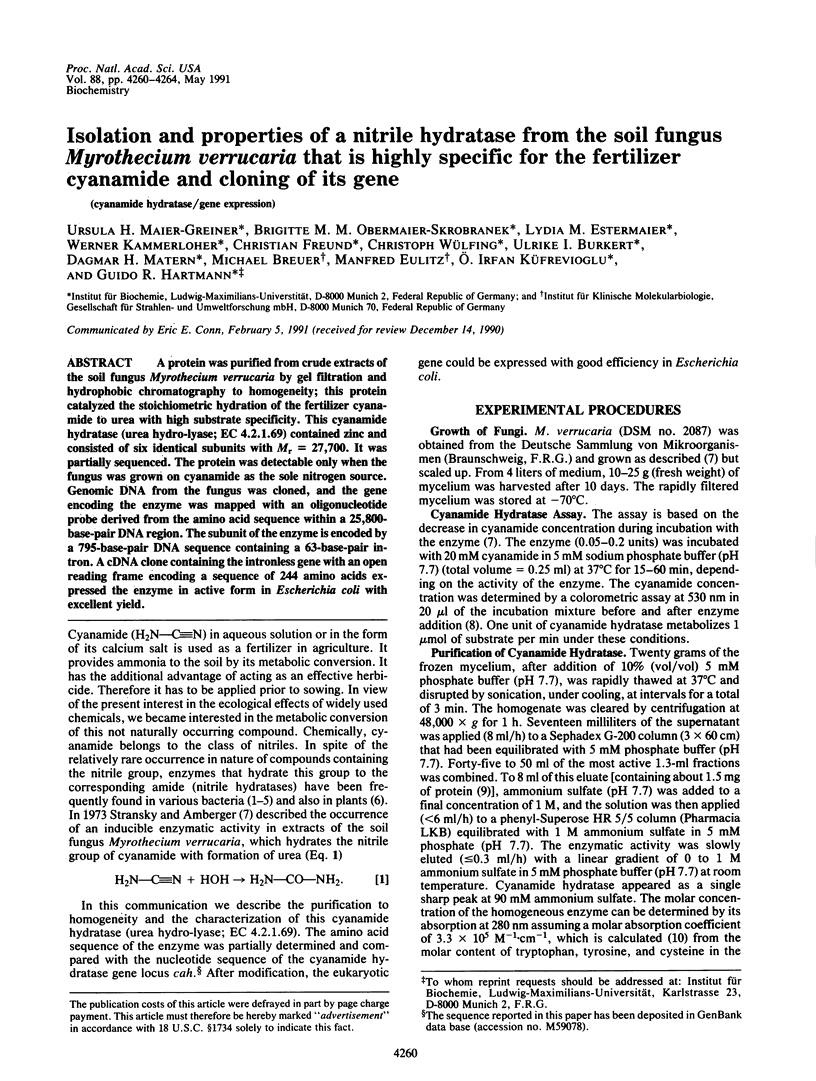
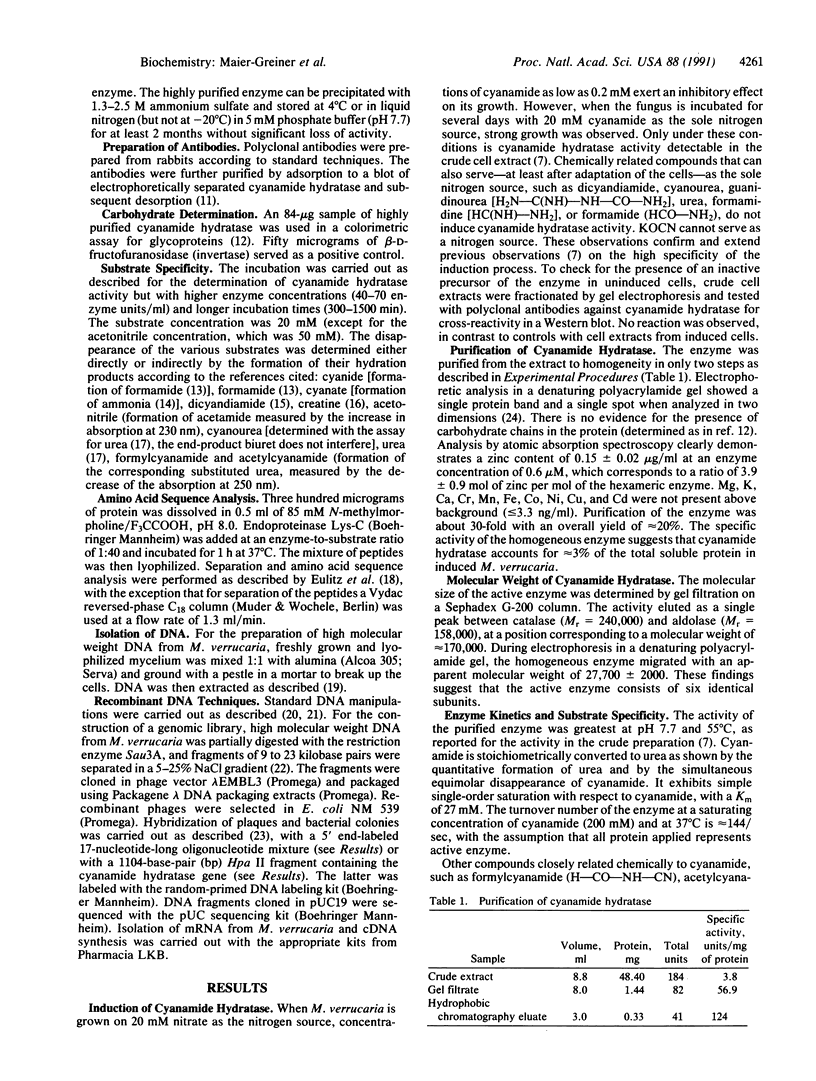
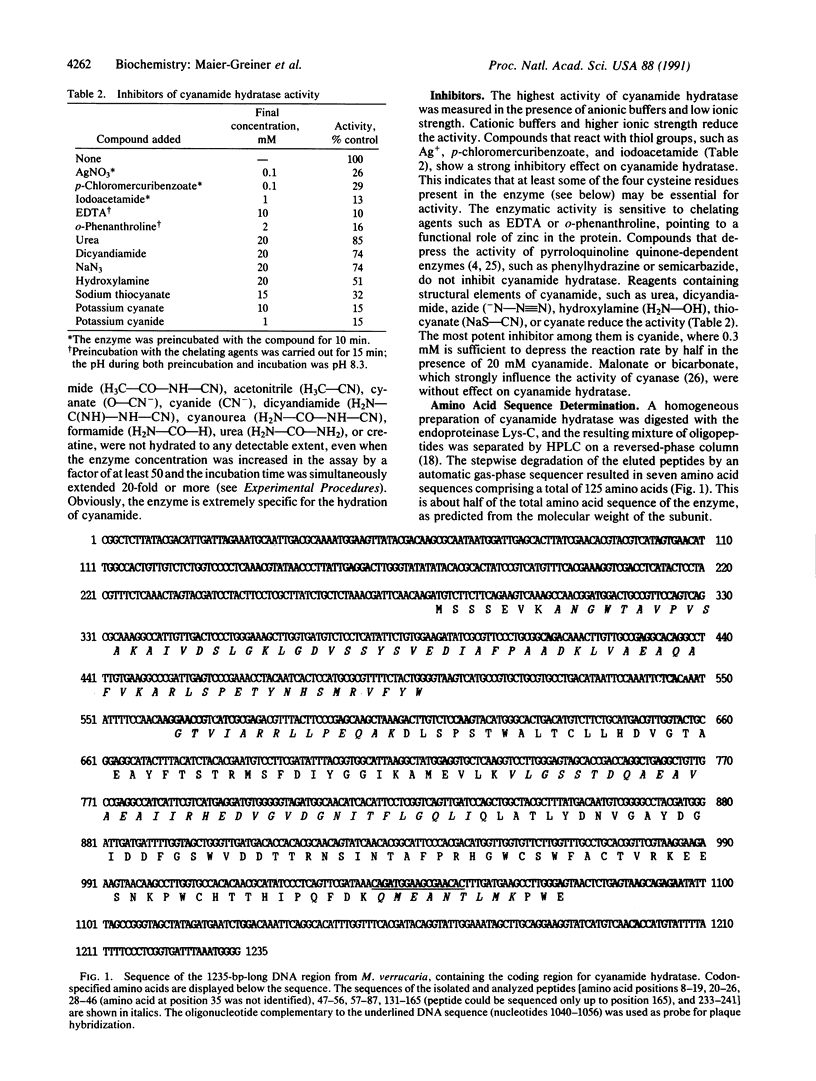
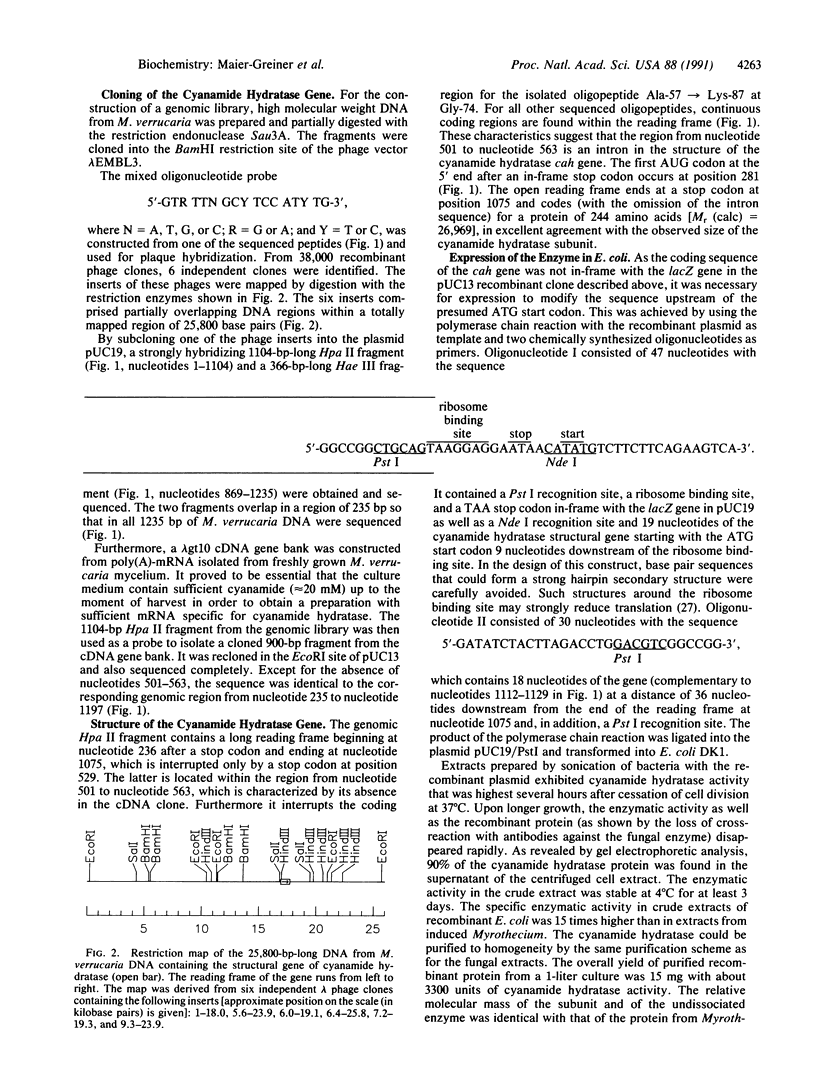
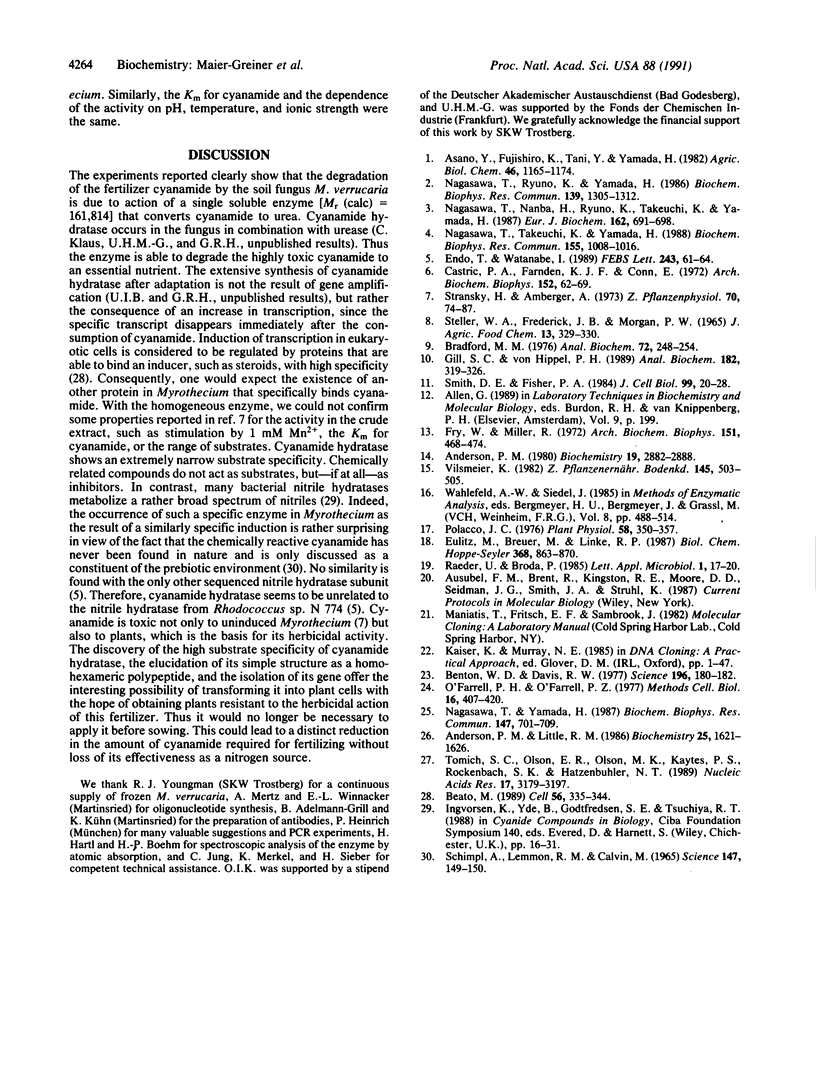
Selected References
These references are in PubMed. This may not be the complete list of references from this article.
- Anderson P. M., Little R. M. Kinetic properties of cyanase. Biochemistry. 1986 Apr 8;25(7):1621–1626. doi: 10.1021/bi00355a026. [DOI] [PubMed] [Google Scholar]
- Anderson P. M. Purification and properties of the inducible enzyme cyanase. Biochemistry. 1980 Jun 24;19(13):2882–2888. doi: 10.1021/bi00554a010. [DOI] [PubMed] [Google Scholar]
- Beato M. Gene regulation by steroid hormones. Cell. 1989 Feb 10;56(3):335–344. doi: 10.1016/0092-8674(89)90237-7. [DOI] [PubMed] [Google Scholar]
- Benton W. D., Davis R. W. Screening lambdagt recombinant clones by hybridization to single plaques in situ. Science. 1977 Apr 8;196(4286):180–182. doi: 10.1126/science.322279. [DOI] [PubMed] [Google Scholar]
- Bradford M. M. A rapid and sensitive method for the quantitation of microgram quantities of protein utilizing the principle of protein-dye binding. Anal Biochem. 1976 May 7;72:248–254. doi: 10.1006/abio.1976.9999. [DOI] [PubMed] [Google Scholar]
- Castric P. A., Farnden K. J., Conn E. E. Cyanide metabolism in higher plants. V. The formation of asparagine from -cyanoalanine. Arch Biochem Biophys. 1972 Sep;152(1):62–69. doi: 10.1016/0003-9861(72)90193-2. [DOI] [PubMed] [Google Scholar]
- Endo T., Watanabe I. Nitrile hydratase of Rhodococcus sp. N-774. Purification and amino acid sequences. FEBS Lett. 1989 Jan 16;243(1):61–64. doi: 10.1016/0014-5793(89)81218-9. [DOI] [PubMed] [Google Scholar]
- Eulitz M., Breuer M., Linke R. P. Is the formation of AL-type amyloid promoted by structural peculiarities of immunoglobulin L-chains? Primary structure of an amyloidogenic lambda-L-chain (BJP-ZIM). Biol Chem Hoppe Seyler. 1987 Jul;368(7):863–870. doi: 10.1515/bchm3.1987.368.2.863. [DOI] [PubMed] [Google Scholar]
- Fry W. E., Millar R. L. Cyanide degradion by an enzyme from Stemphylium loti. Arch Biochem Biophys. 1972 Aug;151(2):468–474. doi: 10.1016/0003-9861(72)90523-1. [DOI] [PubMed] [Google Scholar]
- Gill S. C., von Hippel P. H. Calculation of protein extinction coefficients from amino acid sequence data. Anal Biochem. 1989 Nov 1;182(2):319–326. doi: 10.1016/0003-2697(89)90602-7. [DOI] [PubMed] [Google Scholar]
- Ingvorsen K., Yde B., Godtfredsen S. E., Tsuchiya R. T. Microbial hydrolysis of organic nitriles and amides. Ciba Found Symp. 1988;140:16–31. doi: 10.1002/9780470513712.ch3. [DOI] [PubMed] [Google Scholar]
- Nagasawa T., Nanba H., Ryuno K., Takeuchi K., Yamada H. Nitrile hydratase of Pseudomonas chlororaphis B23. Purification and characterization. Eur J Biochem. 1987 Feb 2;162(3):691–698. doi: 10.1111/j.1432-1033.1987.tb10692.x. [DOI] [PubMed] [Google Scholar]
- Nagasawa T., Ryuno K., Yamada H. Nitrile hydratase of Brevibacterium R312--purification and characterization. Biochem Biophys Res Commun. 1986 Sep 30;139(3):1305–1312. doi: 10.1016/s0006-291x(86)80320-5. [DOI] [PubMed] [Google Scholar]
- Nagasawa T., Takeuchi K., Yamada H. Occurrence of a cobalt-induced and cobalt-containing nitrile hydratase in Rhodococcus rhodochrous J1. Biochem Biophys Res Commun. 1988 Sep 15;155(2):1008–1016. doi: 10.1016/s0006-291x(88)80597-7. [DOI] [PubMed] [Google Scholar]
- Nagasawa T., Yamada H. Nitrile hydratase is a quinoprotein. A possible new function of pyrroloquinoline quinone: activation of H2O in an enzymatic hydration reaction. Biochem Biophys Res Commun. 1987 Sep 15;147(2):701–709. doi: 10.1016/0006-291x(87)90987-9. [DOI] [PubMed] [Google Scholar]
- O'Farrell P. H., O'Farrell P. Z. Two-dimensional polyacrylamide gel electrophoretic fractionation. Methods Cell Biol. 1977;16:407–420. doi: 10.1016/s0091-679x(08)60116-8. [DOI] [PubMed] [Google Scholar]
- Polacco J. C. Nitrogen metabolism in soybean tissue culture: I. Assimilation of urea. Plant Physiol. 1976 Sep;58(3):350–357. doi: 10.1104/pp.58.3.350. [DOI] [PMC free article] [PubMed] [Google Scholar]
- Schimpl A., Lemmon R. M., Calvin M. Cyanamide Formation under Primitive Earth Conditions. Science. 1965 Jan 8;147(3654):149–150. doi: 10.1126/science.147.3654.149. [DOI] [PubMed] [Google Scholar]
- Smith D. E., Fisher P. A. Identification, developmental regulation, and response to heat shock of two antigenically related forms of a major nuclear envelope protein in Drosophila embryos: application of an improved method for affinity purification of antibodies using polypeptides immobilized on nitrocellulose blots. J Cell Biol. 1984 Jul;99(1 Pt 1):20–28. doi: 10.1083/jcb.99.1.20. [DOI] [PMC free article] [PubMed] [Google Scholar]
- Tomich C. S., Olson E. R., Olsen M. K., Kaytes P. S., Rockenbach S. K., Hatzenbuhler N. T. Effect of nucleotide sequences directly downstream from the AUG on the expression of bovine somatotropin in E. coli. Nucleic Acids Res. 1989 Apr 25;17(8):3179–3197. doi: 10.1093/nar/17.8.3179. [DOI] [PMC free article] [PubMed] [Google Scholar]


